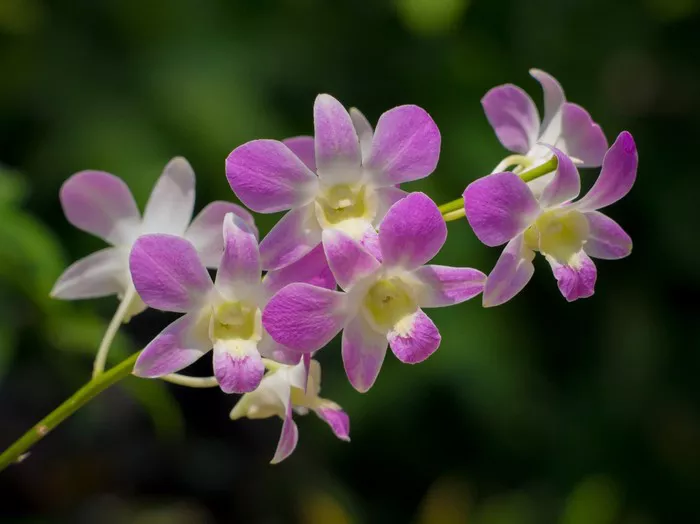Dendrobium orchids, renowned for their stunning blooms and diverse species, captivate both novice and seasoned orchid enthusiasts alike. Their vibrant flowers, often adorning homes and gardens with splendor, eventually fade, leaving caretakers with questions on how to proceed. Proper post-flowering care is essential for the health and longevity of these majestic plants. In this comprehensive guide, we delve into the intricacies of tending to dendrobium orchids after their blossoms have waned, ensuring they thrive for seasons to come.
Understanding Dendrobium Orchids
Before delving into post-flowering care, it’s crucial to understand the nature of dendrobium orchids. Originating from diverse habitats spanning Asia, Australia, and the Pacific Islands, dendrobiums exhibit considerable variability in their growth habits, flower morphology, and environmental requirements. With over 1,800 species and numerous hybrids, these orchids present a rich tapestry of colors, shapes, and sizes, offering something for every orchid enthusiast.
Post-Flowering Maintenance: Key Steps
Once the dazzling blooms of dendrobium orchids have faded, transitioning them into the post-flowering phase is pivotal for their continued health and vitality. Here are the key steps to guide you through this process:
1. Trimming Faded Blooms: As the flowers lose their luster, delicately trim the spent blooms near the base of the stem using sterilized scissors or pruning shears. This not only enhances the plant’s aesthetic appeal but also redirects its energy towards future growth.
2. Assessing the Plant’s Health: Take this opportunity to assess the overall health of the dendrobium orchid. Examine the leaves for signs of discoloration, pests, or disease. Healthy foliage is indicative of a thriving plant, while any abnormalities warrant closer inspection and appropriate action.
3. Adjusting Watering and Fertilization: With the cessation of flowering, adjust the watering and fertilization regimen to correspond with the plant’s reduced energy requirements. Dendrobiums typically benefit from a brief period of rest post-flowering, during which watering should be moderated to prevent overhydration.
4. Providing Adequate Light: Adequate light is essential for the photosynthetic processes that sustain dendrobium orchids. Position them in a location where they receive sufficient but indirect sunlight, avoiding prolonged exposure to intense midday rays, which can scorch delicate foliage.
5. Temperature and Humidity Considerations: Dendrobiums exhibit diverse temperature and humidity preferences, depending on their species or hybrids. While some thrive in warm, humid conditions, others prefer cooler, drier environments. Tailor the growing conditions to accommodate the specific requirements of your dendrobium orchid.
6. Repotting, if Necessary: If the dendrobium orchid has outgrown its current pot or if the growing medium has become depleted, consider repotting during the post-flowering phase. Choose a well-draining potting mix suitable for orchids, ensuring adequate aeration for the roots.
7. Encouraging New Growth: Stimulate new growth by providing optimal growing conditions and maintaining a consistent care routine. Dendrobiums have the remarkable ability to produce new shoots and pseudobulbs, which serve as reservoirs for nutrients and energy.
8. Practicing Patience: Patience is paramount when caring for dendrobium orchids post-flowering. While some varieties may initiate new growth shortly after flowering, others may exhibit a more prolonged resting period before resuming active growth. Observe the plant closely and adjust care accordingly.
Common Challenges and Solutions
Despite meticulous care, dendrobium orchids may encounter various challenges during the post-flowering phase. Here are some common issues and their corresponding solutions:
1. Yellowing Leaves: Yellowing leaves can signify overwatering, nutrient deficiencies, or root rot. Adjust the watering frequency and ensure adequate drainage to prevent waterlogged conditions. Additionally, consider fertilizing with a balanced orchid fertilizer to address any nutrient deficiencies.
2. Pest Infestations: Common pests such as aphids, scale insects, and spider mites may target dendrobium orchids, compromising their health and vigor. Combat pest infestations promptly using organic insecticidal soaps or horticultural oils, ensuring thorough coverage of affected areas.
3. Disease Management: Fungal and bacterial infections can pose significant threats to dendrobium orchids, especially in humid environments. Practice good hygiene by removing dead or decaying plant material and maintaining proper air circulation to minimize the risk of disease spread.
4. Stunted Growth: Stunted growth may result from suboptimal growing conditions, nutrient imbalances, or root-bound conditions. Evaluate the plant’s environment and make necessary adjustments to promote healthy growth. Repotting may be necessary if the root system has outgrown its container.
Conclusion
Caring for dendrobium orchids after flowering is a rewarding endeavor that requires patience, diligence, and a deep understanding of the plant’s needs. By following the steps outlined in this guide and addressing any challenges that arise with prompt action, you can ensure that your dendrobium orchids thrive and grace your home or garden with their beauty for years to come. Remember, each dendrobium is a unique entity, deserving of tailored care and attention to unlock its full potential. With proper post-flowering maintenance, you can maximize the beauty of these exquisite orchids and cultivate a rewarding relationship with these botanical treasures.


